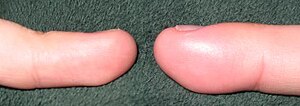Swelling (medical)
| Swelling | |
|---|---|
 |
|
| Left and right ring fingers of the same individual. The distal phalanx of the finger on the right exhibits swelling due to acute paronychia. | |
| Classification and external resources | |
| ICD-10 | R22 |
| ICD-9-CM | 782.2, 784.2, 786.6, 789.3 |
| MedlinePlus | 003103 |
In medical parlance, swelling, turgescence or tumefaction is a transient abnormal enlargement of a body part or area not caused by proliferation of cells. It is caused by accumulation of fluid in tissues. It can occur throughout the body (generalized), or a specific part or organ can be affected (localized). Swelling is usually not dangerous and is a common reaction to a inflammation or a bruise.
Swelling is considered one of the five characteristics of inflammation; along with pain, heat, redness, and loss of function.
In a general sense, the suffix "-megaly" is used to indicate a growth, as in hepatomegaly, acromegaly, and splenomegaly.
A body part may swell in response to injury, infection, or disease. Swelling, especially of the ankle, can occur if the body is not circulating fluid well. If water retention progresses to a symptomatic extent, swelling results.
Generalized swelling, or massive edema (also called anasarca), is a common sign in severely ill people. Although slight edema may be difficult to detect to the untrained eye, especially in an overweight person, massive edema is very obvious.
Traumatic swellings develop immediately after trauma, like a hematoma or dislocation.
Congenital swellings are present since birth, such as a hemangioma or meningocele. Some congenital swellings may not be discovered until later in life, such as a branchial cyst, dermoid cyst or thyroglossal cyst.
...
Wikipedia
